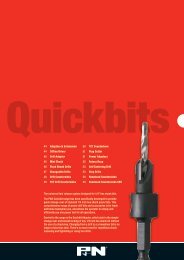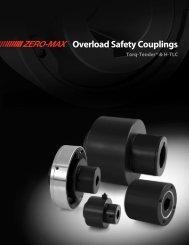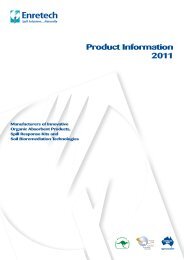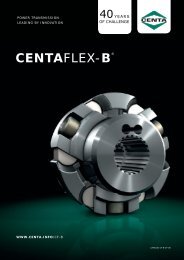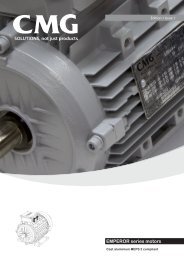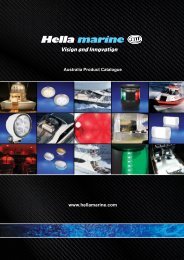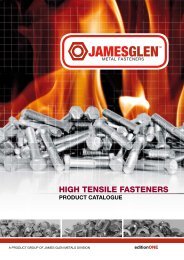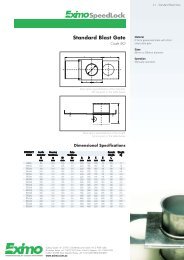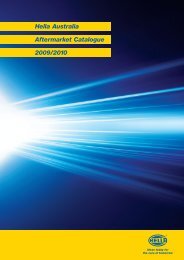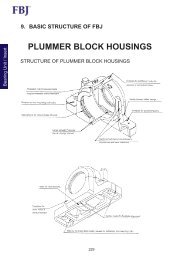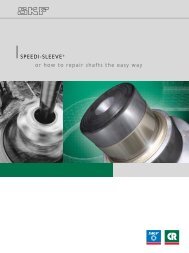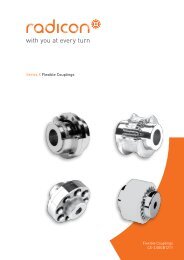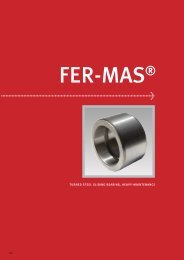Download - Industrial and Bearing Supplies
Download - Industrial and Bearing Supplies
Download - Industrial and Bearing Supplies
Create successful ePaper yourself
Turn your PDF publications into a flip-book with our unique Google optimized e-Paper software.
129<br />
TECHNICAL<br />
Operating principle of an<br />
Inc<strong>and</strong>escent Lamp<br />
The higher the filament temperature, the<br />
higher the luminous efficacy, but the shorter<br />
the lamp life.<br />
A reduction in lamp life is a consequence of<br />
the rapid increase in the rate of vaporization<br />
of the Tungsten atoms as the temperature<br />
rises; this process not only produces a black<br />
coating on the bulb but also ultimately causes<br />
the filament to break.<br />
Blackening of the bulb can be effectively<br />
countered by using as heavy an inert gas<br />
as possible (Argon, Krypton or Xenon) <strong>and</strong><br />
ensuring that this gas is at high pressure<br />
to reduce the rate at which the Tungsten<br />
vaporises.<br />
The principal types of inc<strong>and</strong>escent lamp<br />
are: general-purpose lamps, special-purpose<br />
lamps, decorative lamps <strong>and</strong> inc<strong>and</strong>escent<br />
reflector lamps. The luminous efficacy of<br />
inc<strong>and</strong>escent lamps in the 25 to 1000W range<br />
is between about 9 <strong>and</strong> 19 lm/W for lamps<br />
with an average life of 1000 hours.<br />
%<br />
250<br />
200<br />
65% = 40 000% life<br />
75% = 10 000% life<br />
75% = 3600% life<br />
80% = 1700% life<br />
85% = 1000% life<br />
90% = 600% life<br />
Tungsten-Halogen Lamps<br />
Tungsten-Halogen lamps operate in the<br />
same way as inc<strong>and</strong>escent lamps <strong>and</strong> have<br />
a similar design. The small quantities of<br />
Halogens (Bromine, Chlorine, Fluorine <strong>and</strong><br />
Iodine) <strong>and</strong> their compounds added to the<br />
filler gas, almost entirely prevent the bulb<br />
from blackening due to vaporizing Tungsten<br />
atoms within a particular temperature range,<br />
so there is no associated drop in luminous<br />
flux. The bulbs in Tungsten-Halogen lamps<br />
can therefore be made much smaller, which<br />
means the pressure of the filler gas can be<br />
increased <strong>and</strong> more economical use can<br />
therefore be made of expensive inert gases<br />
like Krypton <strong>and</strong> Xenon. The life of Tungsten<br />
lamps varies from 50 hours for photographic<br />
studio types, to over 2000 hours for<br />
commercial display lighting types. Automotive<br />
Halogen lamps are generally rated in the 300<br />
hour range.<br />
95% = 190% life<br />
Halogen Cycle<br />
As already mentioned, the main<br />
characteristics of an inc<strong>and</strong>escent lamp,<br />
namely its luminous efficacy <strong>and</strong> service<br />
life, are determined to a large extent by the<br />
filament temperature. The higher the filament<br />
temperature, the higher the luminous efficacy<br />
but the shorter the life of the lamp.<br />
This reduction in the life of the lamp is a<br />
consequence of the rate at which Tungsten<br />
vaporises from the filament. This rate<br />
increases rapidly with temperature. Not only<br />
does it blacken the inside of the bulb, it<br />
causes the filament ultimately to burn right<br />
through.<br />
This blackening of the bulb can be effectively<br />
countered by adding halogens to the filler<br />
gas to keep the vaporized Tungsten away<br />
from the bulb wall in a cycle process . The<br />
Tungsten that vaporises from the filament<br />
during normal operation drifts towards<br />
the bulb wall by diffusion or convection<br />
in thermal regions (•1 1400°C) where<br />
they disintegrate. Some of the Tungsten is<br />
transported back to the filament, but not<br />
to its original location. The normal Halogen<br />
cycle therefore merely prevents the bulb from<br />
blackening, it does not extend the life of the<br />
lamp. The lamp comes to the end of its life<br />
when the filament breaks at one of its<br />
hot spots.<br />
150<br />
Lamp life<br />
Light output<br />
Tungsten<br />
Halogenide<br />
Lamp power<br />
Halogen cycle<br />
100<br />
Tungsten<br />
Halogenide<br />
Lamp power<br />
Halogen cycle<br />
50<br />
Light output<br />
Tungsten<br />
Lamp life<br />
Halogenide<br />
0<br />
70 80 90 100 110 120 130 %<br />
Halogen cycle<br />
Halogen Cycle<br />
A regenerative cycle would be feasible with Fluorine<br />
but because this Halogen is so corrosive towards<br />
the quartz <strong>and</strong> hard glass used for the bulb, <strong>and</strong><br />
resistant to the Halogen currently used, a satisfactory<br />
solution has not yet been found.



